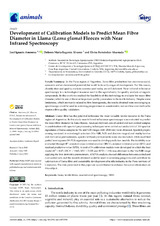Development of Calibration Models to Predict Mean Fibre Diameter in Llama (Lama glama) Fleeces with Near Infrared Spectroscopy
Autor
Amorena, José Ignacio
Álvarez, Dolores María Eugenia
Fernández-Ahumada, Elvira
Editor
MDPIFecha
2021Materia
LlamaTextile fibres
Near infrared spectroscopy
NIRS
METS:
Mostrar el registro METSPREMIS:
Mostrar el registro PREMISMetadatos
Mostrar el registro completo del ítemResumen
Llama fibre has the potential to become the most valuable textile resource in the Puna region of Argentina. In this study near infrared reflectance spectroscopy was evaluated to predict the mean fibre diameter in llama fleeces. Analyses between sets of carded and non-carded samples in combination with spectral preprocessing techniques were carried out and a total of 169 spectral signatures of llama samples in Vis and NIR ranges (400–2500 nm) were obtained. Spectral preprocessing consisted in wavelength selection (Vis–NIR, NIR and discrete ranges) and multiplicative and derivative pretreatments; spectra without pretreatments were also included, while modified partial least squares (M-PLS) regression was used to develop prediction models. Predictability was evaluated through R2: standard cross validation error (SECV), external validation error (SEV) and residual predictive value (RPD). A total of 54 calibration models were developed in which the best model (R2 = 0.67; SECV = 1.965; SEV = 2.235 and RPD = 1.91) was obtained in the Vis–NIR range applying the first derivative pretreatment. ANOVA analysis showed differences between carded and non-carded sets and the models obtained could be used in screening programs and contribute to valorisation of llama fibre and sustainable development of textile industry in the Puna territory of Catamarca. The data presented in this paper are a contribution to enhance the scarce information on this subject.

